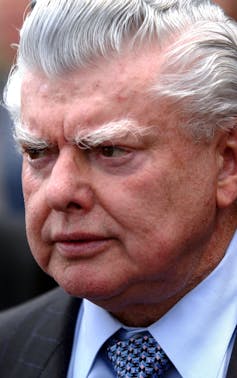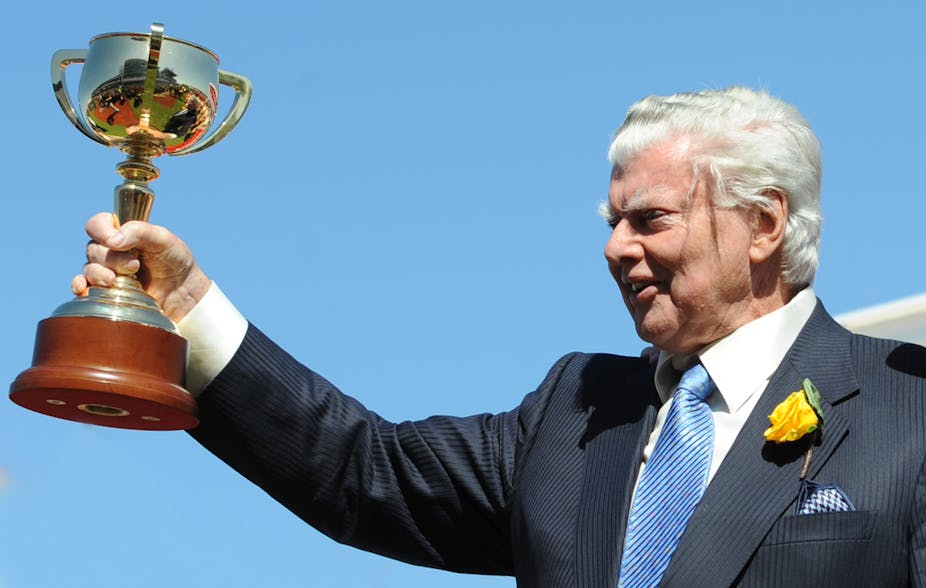A story about racehorse trainer Bart Cummings, who died early Sunday morning at his retreat near Sydney, concerns the enduring Australian obsession with flies. It illustrates both his down-to-earth approach to running a racing stable and his renowned dry wit and ability to produce humorous one-liners.
The story goes that Cummings’ racing stables were being “cased” by a council health inspector. Cummings trailed after the inspector throughout his long examination, trying to look over his shoulder as he scribbled down notes on a clipboard.
Finally the inspector turned to Cummings and announced:
You have too many flies in your stables, Mr Cummings.
Cummings rubbed his chin and scratched his head before responding:
How many are we allowed to have?
Cummings was guest of honour at the launch of the final volume of Andrew Lemon’s monumental History of Australian Thoroughbred Racing at the Australian Racing Museum in 2008. When asked the secret of his remarkable success, Cummings responded that he always looked to the future and never dwelt on the past.
While this announcement may not have been especially welcome to an author trying to launch a work of history – Lemon responded adroitly and with great good humour – it did very succinctly capture Cummings’ life philosophy.
The rise and rise
James Bartholomew Cummings was born on November 14, 1927. His father, Jim, had become a horse trainer after struggling to survive as an up-country South Australian wheat buyer during the great drought of late Victorian and Edwardian Australia.
Fed up with the hard life, Jim Cummings acquired a few thoroughbreds and headed south, destination Adelaide, though he raced his charges at remote racecourses like Jamestown on the way.
By the 1920s Jim Cummings had established a tolerably successful racing stable in Adelaide. The highlight of his training career came in 1950, when his champion, Comic Court, won the Melbourne Cup. Young Bart acted as the horse’s strapper. His future in horseracing was set in stone.
Although Cummings’ relationship with his father, and later his son and grandson – both also horse trainers – had great impacts on his career, he is perhaps associated even more closely with a jockey, Roy Higgins, and a rival trainer, Tommy “T.J.” Smith.
Cummings and Higgins rose to the top of Victorian racing together as trainer and stable jockey in the 1960s. Higgins rode Cummings’ first and third Melbourne Cup winners. The first was the tiny mare, Light Fingers, in 1965. Higgins had nicknamed her “Mother” and both he and Cummings had a special affection for her.
In 1967 Higgins gave Cummings his first Melbourne Cup winner in the trainer’s own colours – the now famous green and gold diagonal stripes – aboard Red Handed. Like Light Fingers, he was the well-named son of sire Le Filou.
The Cummings-Higgins partnership was sundered in the early 1970s over the trainer’s engagement of another jockey for a feature race. Higgins rode rarely for the stable thereafter and partnered none of Cummings’ further nine Cup successes. Instead Harry White (thrice), Darren Beadman (twice), John Duggan, Steven King, John Marshall and Blake Shinn had their names added to lists of “Melbourne Cup winners” on calendars on the back of countless Australian dunny doors.
Where does he rank?
Cummings and Smith contended for the title of the greatest Australian post-war trainer. The judges were the racing press and the public that followed horseracing, which was still enormous in number well into the 1980s. Both were among the inaugural induction of trainers into the Australian Racing Hall of Fame in 2001.
However, Cummings was second inductee in the “legends” category, in 2008. He was nosed out of the winner’s stall by Phar Lap, inducted a year earlier. Smith had to wait until 2012.
The public guessed at a great jealousy existing between the pair, but in the foreword to Bruce Montgomerie’s 1988 biography of Cummings, Smith praised his rival warmly and generously.
Smith revolutionised Australian horseracing with his large team of horses and production-line approach. With his smaller stable, Cummings was perhaps able to concentrate more on individual horses. He was an erudite student of equine breeding and conformation, and pioneered the practice now common among Australian trainers of paying annual visits to the limestone-rich fields of New Zealand to look for future cups winners.
However, Cummings’ interest in racehorses extended to their psychologies. He was convinced that they understand love and affection shown them by humans and, what is more, that they respond to it with improved performances on the racecourse.

Cummings was a man of distinctive and impressive appearance. In youth he had the brooding good looks of a Heathcliff. Later in life he was described as resembling an (unspecified) matinee idol who had gone just slightly to seed. His hair, which had been kept disciplined by Brylcreem throughout the 1950s and 1960s, morphed in the 1970s into a quiff that seemed, like Donald Trump’s, to defy gravity.
Cummings liked to keep up with new fashions. But unlike Tommy Smith, who had more hats than Imelda Marcos had shoes, he usually went bare-headed at the races. In the 1970s he appeared at a post-race presentation in a sports jacket that looked like it had been lent him by US comedian Rodney Dangerfield.
Cummings, as we have seen, did enjoy a laugh and a joke, but he managed to keep a straight face throughout the infamous “emotional” Sir John Kerr Melbourne Cup presentation of 1977 (won by his horse, Gold and Black).
Cummings’ big race success was not limited to the Melbourne Cup. The “Cups King” nickname refers also to his wins in the first leg of the big spring double, the Caulfield Cup. He won it seven times. He also rather specialised in Victoria’s principal sprint race, the Newmarket Handicap, and the three-year-old fillies’ spring classic, the VRC Oaks.
After being slightly slow off the mark, Cummings came into his own as a trainer of Golden Slipper winners in the 1970s. He is one of the most successful trainers in the history of the Cox Plate.
But it is through Cummings’ 12 wins in the Melbourne Cup, more than double those of the next-most-successful trainer, that he has achieved something comparable with Don Bradman’s 99.94 Test batting average – and is unlikely ever to be matched.

